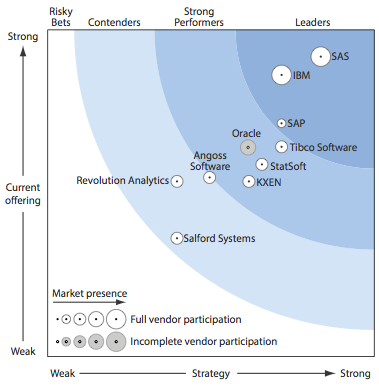 As with so many other companies, the transition to next-generation software platforms is apparently giving SAP a little bit of trouble. Although the company reported a significant rise in revenue from cloud subscriptions and support in the second quarter of 2013, software-related revenue declined 3 percent. Total revenue and profit rose, but so did total operating expenses. Those results came in below some analysts’ estimates, forcing SAP’s stock price slightly downward July 19. SAP is experiencing the same dip in China-related business as other tech firms. “The slowdown in China impacts many countries in Asia and you see that in our numbers this quarter,” co-CEO Jim Hagemann Snabe told analysts and media on an earnings-related conference call, according to Bloomberg. There were other bright spots in SAP’s most recent quarterly statements: the company claims that its HANA in-memory technology, which powers an increasing number of products in its portfolio, enjoyed year-over-year revenue growth of 21 percent. Revenue from the software could hit 700 million Euros in 2013, according to the company. If those numbers prove accurate, it would counter claims from Oracle CEO Larry Ellison that few businesses actually use HANA. “We virtually never see HANA in the market and SAP’s HANA numbers simply don’t add up,” Ellison claimed in June, citing estimates from Cowen & Co. analyst Peter Goldmacher. Given HANA’s increasingly tight integration with the rest of SAP’s product portfolio, the question of how many businesses are actually using the technology may soon become a moot point—any business that relies on SAP could end up relying on HANA in some fashion. Nonetheless, Ellison’s comments about HANA hint at the animosity lingering between SAP and Oracle, despite the latter recently signing alliances with other longtime rivals such as Salesforce and Microsoft. Both companies compete fiercely for enterprise contracts, and—when not taking shots at mutual opponent Workday—both have made a sport out of promoting their own offerings at the expense of the other. Over the past few quarters, both Oracle and SAP have also accelerated their move to the cloud, which has created a whole new battleground (not to mention more than enough trash-talking from Ellison to keep the tech press happy). Oracle’s been dealing with some earnings issues of its own, of course: last quarter, its revenues from new software licenses and cloud-software subscriptions were up 1 percent, to $4.0 billion, while its hardware division continued to suffer. Transitions can be painful for everyone. Image: Helmut Spoonwood/Shutterstock.com
As with so many other companies, the transition to next-generation software platforms is apparently giving SAP a little bit of trouble. Although the company reported a significant rise in revenue from cloud subscriptions and support in the second quarter of 2013, software-related revenue declined 3 percent. Total revenue and profit rose, but so did total operating expenses. Those results came in below some analysts’ estimates, forcing SAP’s stock price slightly downward July 19. SAP is experiencing the same dip in China-related business as other tech firms. “The slowdown in China impacts many countries in Asia and you see that in our numbers this quarter,” co-CEO Jim Hagemann Snabe told analysts and media on an earnings-related conference call, according to Bloomberg. There were other bright spots in SAP’s most recent quarterly statements: the company claims that its HANA in-memory technology, which powers an increasing number of products in its portfolio, enjoyed year-over-year revenue growth of 21 percent. Revenue from the software could hit 700 million Euros in 2013, according to the company. If those numbers prove accurate, it would counter claims from Oracle CEO Larry Ellison that few businesses actually use HANA. “We virtually never see HANA in the market and SAP’s HANA numbers simply don’t add up,” Ellison claimed in June, citing estimates from Cowen & Co. analyst Peter Goldmacher. Given HANA’s increasingly tight integration with the rest of SAP’s product portfolio, the question of how many businesses are actually using the technology may soon become a moot point—any business that relies on SAP could end up relying on HANA in some fashion. Nonetheless, Ellison’s comments about HANA hint at the animosity lingering between SAP and Oracle, despite the latter recently signing alliances with other longtime rivals such as Salesforce and Microsoft. Both companies compete fiercely for enterprise contracts, and—when not taking shots at mutual opponent Workday—both have made a sport out of promoting their own offerings at the expense of the other. Over the past few quarters, both Oracle and SAP have also accelerated their move to the cloud, which has created a whole new battleground (not to mention more than enough trash-talking from Ellison to keep the tech press happy). Oracle’s been dealing with some earnings issues of its own, of course: last quarter, its revenues from new software licenses and cloud-software subscriptions were up 1 percent, to $4.0 billion, while its hardware division continued to suffer. Transitions can be painful for everyone. Image: Helmut Spoonwood/Shutterstock.com SAP Experiencing Same Software-Revenue Grind As Other Firms
 As with so many other companies, the transition to next-generation software platforms is apparently giving SAP a little bit of trouble. Although the company reported a significant rise in revenue from cloud subscriptions and support in the second quarter of 2013, software-related revenue declined 3 percent. Total revenue and profit rose, but so did total operating expenses. Those results came in below some analysts’ estimates, forcing SAP’s stock price slightly downward July 19. SAP is experiencing the same dip in China-related business as other tech firms. “The slowdown in China impacts many countries in Asia and you see that in our numbers this quarter,” co-CEO Jim Hagemann Snabe told analysts and media on an earnings-related conference call, according to Bloomberg. There were other bright spots in SAP’s most recent quarterly statements: the company claims that its HANA in-memory technology, which powers an increasing number of products in its portfolio, enjoyed year-over-year revenue growth of 21 percent. Revenue from the software could hit 700 million Euros in 2013, according to the company. If those numbers prove accurate, it would counter claims from Oracle CEO Larry Ellison that few businesses actually use HANA. “We virtually never see HANA in the market and SAP’s HANA numbers simply don’t add up,” Ellison claimed in June, citing estimates from Cowen & Co. analyst Peter Goldmacher. Given HANA’s increasingly tight integration with the rest of SAP’s product portfolio, the question of how many businesses are actually using the technology may soon become a moot point—any business that relies on SAP could end up relying on HANA in some fashion. Nonetheless, Ellison’s comments about HANA hint at the animosity lingering between SAP and Oracle, despite the latter recently signing alliances with other longtime rivals such as Salesforce and Microsoft. Both companies compete fiercely for enterprise contracts, and—when not taking shots at mutual opponent Workday—both have made a sport out of promoting their own offerings at the expense of the other. Over the past few quarters, both Oracle and SAP have also accelerated their move to the cloud, which has created a whole new battleground (not to mention more than enough trash-talking from Ellison to keep the tech press happy). Oracle’s been dealing with some earnings issues of its own, of course: last quarter, its revenues from new software licenses and cloud-software subscriptions were up 1 percent, to $4.0 billion, while its hardware division continued to suffer. Transitions can be painful for everyone. Image: Helmut Spoonwood/Shutterstock.com
As with so many other companies, the transition to next-generation software platforms is apparently giving SAP a little bit of trouble. Although the company reported a significant rise in revenue from cloud subscriptions and support in the second quarter of 2013, software-related revenue declined 3 percent. Total revenue and profit rose, but so did total operating expenses. Those results came in below some analysts’ estimates, forcing SAP’s stock price slightly downward July 19. SAP is experiencing the same dip in China-related business as other tech firms. “The slowdown in China impacts many countries in Asia and you see that in our numbers this quarter,” co-CEO Jim Hagemann Snabe told analysts and media on an earnings-related conference call, according to Bloomberg. There were other bright spots in SAP’s most recent quarterly statements: the company claims that its HANA in-memory technology, which powers an increasing number of products in its portfolio, enjoyed year-over-year revenue growth of 21 percent. Revenue from the software could hit 700 million Euros in 2013, according to the company. If those numbers prove accurate, it would counter claims from Oracle CEO Larry Ellison that few businesses actually use HANA. “We virtually never see HANA in the market and SAP’s HANA numbers simply don’t add up,” Ellison claimed in June, citing estimates from Cowen & Co. analyst Peter Goldmacher. Given HANA’s increasingly tight integration with the rest of SAP’s product portfolio, the question of how many businesses are actually using the technology may soon become a moot point—any business that relies on SAP could end up relying on HANA in some fashion. Nonetheless, Ellison’s comments about HANA hint at the animosity lingering between SAP and Oracle, despite the latter recently signing alliances with other longtime rivals such as Salesforce and Microsoft. Both companies compete fiercely for enterprise contracts, and—when not taking shots at mutual opponent Workday—both have made a sport out of promoting their own offerings at the expense of the other. Over the past few quarters, both Oracle and SAP have also accelerated their move to the cloud, which has created a whole new battleground (not to mention more than enough trash-talking from Ellison to keep the tech press happy). Oracle’s been dealing with some earnings issues of its own, of course: last quarter, its revenues from new software licenses and cloud-software subscriptions were up 1 percent, to $4.0 billion, while its hardware division continued to suffer. Transitions can be painful for everyone. Image: Helmut Spoonwood/Shutterstock.com 
